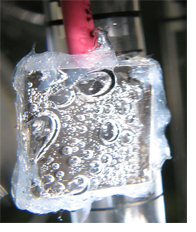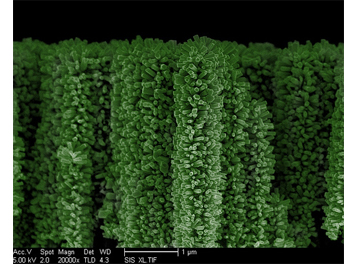Solar Fuel Conversion
 Sunlight and seawater are the ultimate and sustainable energy sources on earth, and together they constitute a potential solution to the global energy crisis, which at the same time can reduce the carbon emission due to the use of fossil fuels. A photoelectrochemical (PEC) cell utilizes solar energy to directly split water and generate H2, which is clean and free of carbon emission. However, it is broadly recognized by the PEC community that there is no single material can be the perfect photoelectrode candidate for solar water splitting with respect to light absorption, water reduction, chemical stability, etc.
Sunlight and seawater are the ultimate and sustainable energy sources on earth, and together they constitute a potential solution to the global energy crisis, which at the same time can reduce the carbon emission due to the use of fossil fuels. A photoelectrochemical (PEC) cell utilizes solar energy to directly split water and generate H2, which is clean and free of carbon emission. However, it is broadly recognized by the PEC community that there is no single material can be the perfect photoelectrode candidate for solar water splitting with respect to light absorption, water reduction, chemical stability, etc.
 Our research project focuses on using three dimensional (3D) tree-like branched nanowire heterostructures from earth abundant materials by low-cost fabrication process as photoelectrodes for high efficiency, and potentially practical and sustainable clean hydrogen generation. The array of the tree-like 3D branched nanowires offer a unique combination of desired properties that are critical to high efficiency PEC hydrogen generation, such as enhanced light absorption, improved charge separation/collection, and enlarged surface area and better electrochemical reaction dynamics. Specifically, the proposed research focus will be on (i) design and fabrication of the 3D nanostructured photoelectrodes using earth abundant materials by low cost solution processes, (ii) understanding of the interface between the nanowire core and branches and their effect to separation and transport of the photogenerated charge carriers, and (iii) understanding of the electrolyte/nanowire interface, and particularly the surface electrochemical reaction/corrosion of semiconductor electrodes at high local acidic/basic condition. We also work on the use of these new nanomaterials for CO2 reduction and solar fuel conversion.
Our research project focuses on using three dimensional (3D) tree-like branched nanowire heterostructures from earth abundant materials by low-cost fabrication process as photoelectrodes for high efficiency, and potentially practical and sustainable clean hydrogen generation. The array of the tree-like 3D branched nanowires offer a unique combination of desired properties that are critical to high efficiency PEC hydrogen generation, such as enhanced light absorption, improved charge separation/collection, and enlarged surface area and better electrochemical reaction dynamics. Specifically, the proposed research focus will be on (i) design and fabrication of the 3D nanostructured photoelectrodes using earth abundant materials by low cost solution processes, (ii) understanding of the interface between the nanowire core and branches and their effect to separation and transport of the photogenerated charge carriers, and (iii) understanding of the electrolyte/nanowire interface, and particularly the surface electrochemical reaction/corrosion of semiconductor electrodes at high local acidic/basic condition. We also work on the use of these new nanomaterials for CO2 reduction and solar fuel conversion.
This research is sponsored by the National Science Foundation (NSF) and the Department of Energy (DOE).







